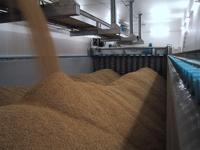Locations of the malthouses in Scotland & the UK
Contents

Image courtesy of Peter Schill
Maltings produce ready to use malted barley for the whisky industry. While small inhouse maltings like those at Bowmore carry out steeping, germination and kilning seperately thse stages can be combined at scale. At industrial sites the production process can be carried out in a combination of seperate or dedicated devices such as:
- Dedicated conical or flat-bottomed steeping vessels
- Dedicated germination x
- Kilns
- Combined steeping and germination vessels (SGV)
- Germination and Kilning Vessels (GKV)
- Steeping, germination and kilning vessels (SGKV)
Most modern maltings utilise entirely automated systems throughout the process. Drum maltings which replaced Saladin boxes are not generally used at industrial maltings.
Scottish distilleries with their own on-site malting
- Ardnamurchan
- Balvenie
- Benriach
- Bowmore
- Highland Park
- Kilchoman
- Laphroaig
- Roseisle (also produces malt for other Diageo distilleries)
- Glen Ord (also produces malt for other Diageo distilleries)
- Springbank
Bruichladdich has plans for the consutruction of its own maltings for 2023.
Diageo malting plants that supply several distilleries
- Burghead Maltings
- Glen Ord Maltings
- Port Ellen Maltings
- Roseisle Maltings
Burghead Maltings
- 48 Steeping Vessels for 15 tons of barley each,
- 48 Drum-Germination Vessels ) with a capacity of 60 tons each
- 3 drying ovens (Kiln) with a capacity of 120 tons each
- 4 drying ovens (Kiln) with a capacity of 60 tons each 85,000 tons of malt production per year
Glen Ord Maltings
- 18 Steeping Vessels for 15 tons of barley each
- 18 malting drums (drum germination vessels) with a capacity of 35 tons each
- 2 drying ovens (Kiln) 35,000 tons of malt production per year
Port Ellen Maltings
- 8 funnel softeners (steeping vessels) for 15 tons of barley each
- 7 malting drums (drum germination vessels) with 60 ton capacity
- 3 kilns (Kiln) with 60 tons capacity 22,000 tons of malt production in year
Roseisle Maltings
- One Steeping Vessel for 325 tonnes of barley
- 2 germination units with integrated drying oven (GKV) with a capacity of around 250 tons 27,000 tons of malt production per year
Industrial maltings
| Maltings | Group |
|---|---|
| Arbroath Maltings | Bairds Malt |
| Inverness Maltings | Bairds Malt |
| Pencaitland Maltings | Bairds Malt |
| Buckie Maltings | Boortmalt |
| Glenesk Maltings | Boortmalt |
| Alloa Maltings | Crisp Malt |
| Portgordon Maltings | Crisp Malt |
| Berwick-upon-Tweed Maltings | Simpsons Malt |
Bairds Malt
Bairds operate 3 maltings and one storage facility.
Arbroath Maltings
Plant 1 (in operation since 1980):
- 8 steeping vessels
- 2 germination units with integrated drying oven (GKV)
22,000 tons of malt production in year
Plant 2 (in operation since 2010):
- 1 tower malt house with 3 germination units (SGV)
- 1 drying oven (Kiln)
57,000 tons of malt production in year
Inverness Maltings
- 15 boxes with integrated drying ovens (SGKV)
45,000 tons of malt production per year
Pencaitland Maltings
- Steeping Vessels
- Malting boxes (GV)
- Drying furnace (Kiln)
47,000 tons of malt production per year
Turriff Grain storage
36,000 tons of storage capacity
Boortmalt
Boortmalt operate 2 maltings
Buckie Maltings
- Steeping Vessels
- 2 germination units with integrated drying oven (GKV)
27,000 tons of malt production per year
Glenesk Maltings
- 24 Steeping Vessels
- 24 Malting Drums (Drum-Germination Vessels)
- Kiln
48,000 tons of malt production per year
Crisp Malt
Boortmalt operate the Alloa maltings
Alloa Maltings
- Boxes with integrated drying furnace (SGKV)
30,000 tons of malt production in Year
Portgordon Maltings
- Steeping Vessels
- 4 germination units with integrated drying oven (GKV)
40,000 tons of malt production per year
Alloa grain storage
40,000 tons storage capacity
Simpsons Malt
Simpsons operate the Berwick-upon-Tweed Maltings
Berwick-upon-Tweed Maltings (North England)
Plant 1:
- Steeping Vessels
- Malting Boxes (GV)
- Kiln
Plant 2:
- Steeping Vessels
- 5 germination units with integrated drying oven (GKV)
Plant 3 (in operation since 2006):
- Steeping Vessels
- 4 germination units with integrated drying oven (GKV) altogether
235,000 tons of malt production per year
FAQs
What does a Maltings do?
A maltings is an industrial factory which carries out the process of steeping, germinating and drying grain to convert it into malt. Maltings mainly supply the brewing and whisky making industry but can also be used to make malt vinegar.
What is the purpose of malting?
Malting is a controlled germination process that turns grain into malt converting the starch into sugar for the production of alcohol. The germination process activates and forms enzymes in the grain, which are later necessary for the breakdown of starch and protein during brewing as well as for whisky production.
What are the steps in the malting process?
The malting process consists of 4 stages which are steeping, germination, kilning and deculming.
What occupation is a Maltster?
Brewers and maltsters work in breweries and malt houses. They can also work for manufacturers of beer and yeast extracts or in companies that produce fruit and vegetable juices and other non-alcoholic beverages.
What is a Malt Shovel?
A malt shovel is a shovel traditionally used by a maltster to turn grain by hand during the malting process. Malt shovels have entirely been replaced by machinery.
What were Malthouses used for?
Malthouses were traditionally attached to farms, breweries and distilleries. Historically, breweries and distilleries malted themselves. With increasing industrialization in the middle of the 19th century, the production of malt separated more and more from the production of beer and whisky, and the malt houses became independent companies. The traditional buildings are generally converted for other uses, or as visitor centres.
Why does green malt have to be kilned?
To use green malt to be used for the production of beer or whisky it is dried in a kiln making the malt durable and storable.
Previous
Next

